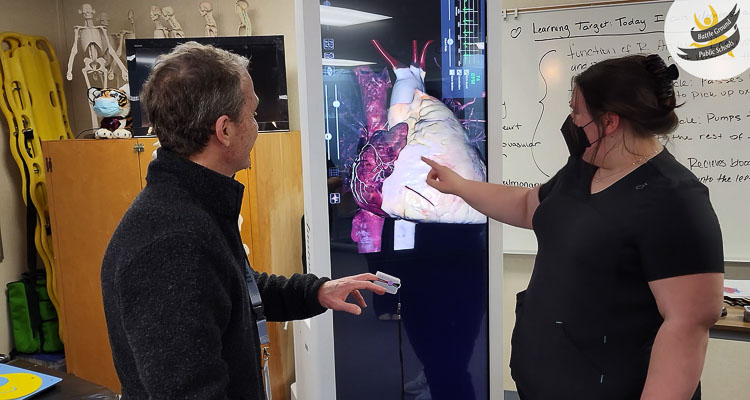Students use the high-tech computer to conduct virtual dissections on images of real-life bodies that were donated for science
Health Science students at Battle Ground High School used to sit on foam pads on the floor to practice CPR or first aid. Today, they have access to exam tables, a hospital bed, interactive CPR dummies, and a state-of-the-art virtual dissection table.
With its large rectangular screen and sleek white exterior, the Anatomage Table looks like something plucked out of a science fiction movie. Students use the high-tech computer to conduct virtual dissections on images of real-life bodies that were donated for science. They can view a beating heart, explore the impact of various diseases or injuries, and drill down to closely study each system of the human body.
“This table has really opened up a lot for us and extended our learning,” said Gabriela Garcia, a sophomore in Tracee Godfrey’s Advanced Health Science Careers class.

The district’s Board of Directors approved the purchase of two Anatomage tables in July 2020 to support Career and Technical Education (CTE) students at Battle Ground and Prairie high schools in Advanced Health Science Careers, Animal Science, and Forensic Science. Battle Ground Public Schools offers nearly 500 CTE courses each year to middle and high school students across the district. The courses span nearly every industry, from engineering and automotive technology to welding and culinary arts, and give students the opportunity to try different career paths. In higher level CTE courses, students often can earn college credit and learn the same skills that they’d have to pay to learn in college.
In the Advanced Health Science Careers class, this is the first year students have been able to roll up their sleeves and take full advantage of the education the Anatomage table provides. “It really brings things full circle,” said Grace Sigler, a senior who plans to attend Central Washington University and pursue a career as a paramedic. “Our mannequins are as real as we can make it, but seeing the body like this really adds that element of ‘this is why you’re doing what you’re doing.’”
In one scenario, students use a pulse oximeter to learn their heart rate. That information is transferred to the table, resulting in a real-time approximation of what their own beating heart looks like. They can even manipulate the images to see multiple dimensions, view all the parts of the heart and see how it works.
“It really is taking this class to the next level,” Garcia said.
“The ultimate impact you are all going to have on society is huge,” Superintendent Denny Waters said during a recent visit to the class. “Good for you, and good for us. I’m so glad we had the chance to give you this opportunity.”
Godfrey’s classroom has evolved in other ways this year, to emphasize hands-on, real-life learning. “I got a call from our HOSA (Health Occupations Students of America) advisory board,” she said. “And they had some exam tables that were supposed to go to Africa but didn’t because of the pandemic. They offered them to us, and of course I said yes.”
The class also received a donated bariatric care bed from a local hospice center. Then the Red Cross helped purchase a stretcher to thank the HOSA students for coordinating blood drives in the area. The district’s CTE department also purchased a hospital bed that students can use to learn how to respond when a patient’s heart has stopped.
Godfrey and a host of HOSA volunteers used the equipment to set up stations that mimic a doctor’s office, hospital room, hospice care, and dental office. The stations help to build more student engagement. “We all know when students enjoy learning, they remember more,” Godfrey said.
On a typical day, Godfrey’s students divide into groups and spread among the various stations. Some students pose as victims of an accident or medical emergency, while others work together to respond to the situation. At another station they might practice CPR, proper bandaging techniques, or how to use an automatic defibrillator.
“It gives us the ability to go into a situation and learn how to react to things as they change,” Garcia said. “And that really helps those of us who want to go into the medical profession to have a leg up when we get to the next level of our education.”
Even when students don’t go on to a medical career, the education they get may help them save a life by knowing how to respond in an emergency and take control of the situation.
Students use the Anatomage table nearly every day. Godfrey said it has greatly increased her student’s interest in learning about medical science and human anatomy. They’ve also seen enrollment in the HOSA program jump this year as those excited students spread the word about the opportunities the real-life classroom provides.
“I’ve heard a lot of great things about it, but just being able to see the table in person and experience the entirety of the program is very impressive,” Waters told the class. “You guys are very impressive.”
Information provided by Battle Ground School District.




